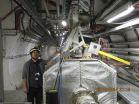New model of cognitive flexibility gives insight into autism spectrum disorder
Being in the present means constantly changing: University of Miami researchers propose a model of cognitive flexibility that helps scientists understand autism spectrum disorder and other behavioral and neurological disorders
2015-09-03
(Press-News.org) Coral Gables, Fla. (September 1, 2015) - Cognitive flexibility is the ability to shift our thoughts and adapt our behavior to the changing environment. In other words, it's one's ability to disengage from a previous task and respond effectively to a new one. It's a faculty that most of us take for granted, yet an essential skill to navigate life.
In a new paper published in the journal Trends in Neurosciences, University of Miami (UM) College of Arts & Sciences researchers clarify many of the concepts surrounding cognitive flexibility and propose a model of its underlying neural mechanisms. The new model may be instrumental in understanding behavioral and neurological disorders, such as autism spectrum disorder.
"By understanding how the brain attempts to implement cognitive flexibility in a neurodevelopmental disorder like autism, we can better understand the nature of the disorder," said Dina R. Dajani, Ph.D. student of psychology in the UM College of Arts & Sciences and first author of the study. "The model will inform whether we should try to teach individuals with autism the strategies utilized by typically developing individuals, or instead improve upon already existing strategies of individuals with the disorder."
For instance, knowing if there is a simple increase or decrease in connectivity between brain regions compared to healthy individuals, or whether those with autism use entirely different brain regions to implement cognitive flexibility will enable researchers to better design interventions to improve cognitive flexibility skills.
The more cognitive flexibility an individual has, the greater his or her chances of doing well in life. Previous studies have shown that greater cognitive flexibility relates to better reading abilities as a child, resilience as an adult, and quality of life in the advanced years.
"Our goal was to summarize and provide directions for future research on a topic that is relevant for understanding several prevalent developmental disorders," said Lucina Q. Uddin, assistant professor of psychology in the UM College of Arts & Sciences, principal investigator of this study and co-author of the paper. "We believe that a better understanding of the neural systems mediating this critical ability will help clinicians design more effect treatments to help individuals who have difficulty with flexible behaviors in daily life, particularly those with autism."
In the paper, the researchers analyzed the existing literature and neuroimaging studies on cognitive flexibility and put forth a hypothesis regarding the fundamental neural mechanisms of this important faculty. The researchers suggest four components that work together to implement cognitive flexibility: salience detection/attention (both achieve similar goals to direct attention to behaviorally relevant events), working memory, inhibition and switching.
If their model is validated, it will provide a strong foundation for researchers to use as a basis in determining what may be wrong in individuals with impaired cognitive flexibility.
"Our concept is quite different from other conceptualizations of cognitive flexibility because we describe it as arising from four separate cognitive operations, whereas other researchers have described it as a manifestation of a single cognitive operation," Dajani said. "This novel hypothesis may help our understanding of this complex ability."
The title of the study is "Demystifying cognitive flexibility: Implications for clinical and developmental neuroscience." The researchers are now using functional neuroimaging to test the "four components" cognitive flexibility hypothesis.
INFORMATION:
- http://www.as.miami.edu/news -
The University of Miami's mission is to educate and nurture students, to create knowledge, and to provide service to our community and beyond. Committed to excellence and proud of our diversity of our University family, we strive to develop future leaders of our nation and the world.
ELSE PRESS RELEASES FROM THIS DATE:
2015-09-03
Researchers involved in an international collaboration across six institutions, including the University of Copenhagen and the National Aquarium of Denmark (Den Blå Planet), have successfully identified the exact composition of sea snake venom, which makes the future development of synthetic antivenoms more realistic. Currently, sea snake anitvenom costs nearly USD 2000, yet these new findings could result in a future production of synthetic antivenoms for as little as USD 10-100.
Venomous snakebites represent a major health concern in many tropical and subtropical ...
2015-09-03
Sea level rise poses one of the biggest threats to human systems in a globally warming world, potentially causing trillions of dollars' worth of damages to flooded cities around the world. As surface temperatures rise, ice sheets are melting at record rates and sea levels are rising.
But there may be some good news amid the worry. Sea levels may not rise as high as assumed.
To predict sea level changes, scientists look to Earth's distant past, when climate conditions were similar to today, and investigate how the planet's ice sheets responded then to warmer temperatures ...
2015-09-03
High blood sugar is a defining characteristic of Type 2 diabetes and the cause of many of the condition's complications, including kidney failure, heart disease, and blindness. Most diabetes medications aim to maintain normal blood sugar (glucose) levels and prevent high blood sugar by controlling insulin.
A new University of Iowa study shows that another biological checkpoint, known as the Mitochondrial Pyruvate Carrier (MPC), is critical for controlling glucose production in the liver and could potentially be a new target for drugs to treat diabetes.
The study, led ...
2015-09-03
LAWRENCE -- Researchers at the University of Kansas working with an international team at the Large Hadron Collider have produced quark-gluon plasma -- a state of matter thought to have existed right at the birth of the universe -- with fewer particles than previously thought possible.
The material was discovered by colliding protons with lead nuclei at high energy inside the supercollider's Compact Muon Solenoid detector. Physicists have dubbed the resulting plasma the "littlest liquid."
"Before the CMS experimental results, it had been thought the medium created in ...
2015-09-03
DARIEN, IL - A new study shows that high school students lose sleep on school nights following the change to daylight saving time that occurs in March. The loss of sleep during the school week was associated with a decline in vigilance and cognitive function, which raises safety concerns for teen drivers.
Results show that the average objectively measured sleep duration on the weeknights after the spring time change declined to 7 hours, 19 minutes, which reflects a mean loss of 32 minutes per night compared with the school week prior to the implementation of daylight ...
2015-09-03
MADISON, Wis. - Orchids, a fantastically complicated and diverse group of flowering plants, have long blended the exotic with the beautiful. Most species live on trees, often in remote, tropical mountains. Their flowers can be strange -- one even flowers underground, and many species deceive their pollinators into thinking they are good to eat.
Some are florist's staples, like phalaenopsis, the hot-pink and white flower that is easy to grow and easier to sell. Beyond the "job" of looking beautiful, only the vanilla orchids have any commercial role.
The estimated ...
2015-09-03
Repeated exposure to anesthesia early in life causes alterations in emotional behavior that may persist long-term, according to a study from the Icahn School of Medicine at Mount Sinai in collaboration with the Yerkes National Primate Research Center, and published in the Online First edition of Anesthesiology, the official medical journal of the American Society of Anesthesiologists®.
Each year, approximately one million children under the age of four undergo surgery with general anesthesia, according to the U.S. Food and Drug Administration (FDA). Retrospective ...
2015-09-03
A study that used stored blood samples from U.S. Air Force personnel who conducted aerial herbicide spray missions of Agent Orange during the Vietnam war found a more than 2-fold increased risk of the precursor to multiple myeloma known as monoclonal gammopathy of undetermined significance (MGUS), according to an article published online by JAMA Oncology.
While the cause of MGUS and multiple myeloma (plasma cell cancer) remains largely unclear, studies have reported an elevated risk of multiple myeloma among farmers and other agricultural workers and pesticides have ...
2015-09-03
CAMBRIDGE, Mass. -- The technology behind 3-D printing is growing more and more common, but the ability to create designs for it is not. Any but the simplest designs require expertise with computer-aided design (CAD) applications, and even for the experts, the design process is immensely time consuming.
Researchers at MIT and the Interdisciplinary Center Herzliya in Israel aim to change that, with a new system that automatically turns CAD files into visual models that users can modify in real time, simply by moving virtual sliders on a Web page. Once the design meets ...
2015-09-03
CAMBRIDGE, Mass. (September 3, 2015) - In the breast, cancer stem cells and normal stem cells can arise from different cell types but tap into distinct yet related stem cell programs, according to Whitehead Institute researchers. The differences between these stem cell programs may be significant enough to be exploited by future therapeutics.
Deadly tumor-initiating cells seed metastases throughout the body and cause relapses in patients. Whether these tumor-initiating cells can also be referred to as stem cells, specifically, cancer stem cells, has been up for debate. ...
LAST 30 PRESS RELEASES:
[Press-News.org] New model of cognitive flexibility gives insight into autism spectrum disorder
Being in the present means constantly changing: University of Miami researchers propose a model of cognitive flexibility that helps scientists understand autism spectrum disorder and other behavioral and neurological disorders


